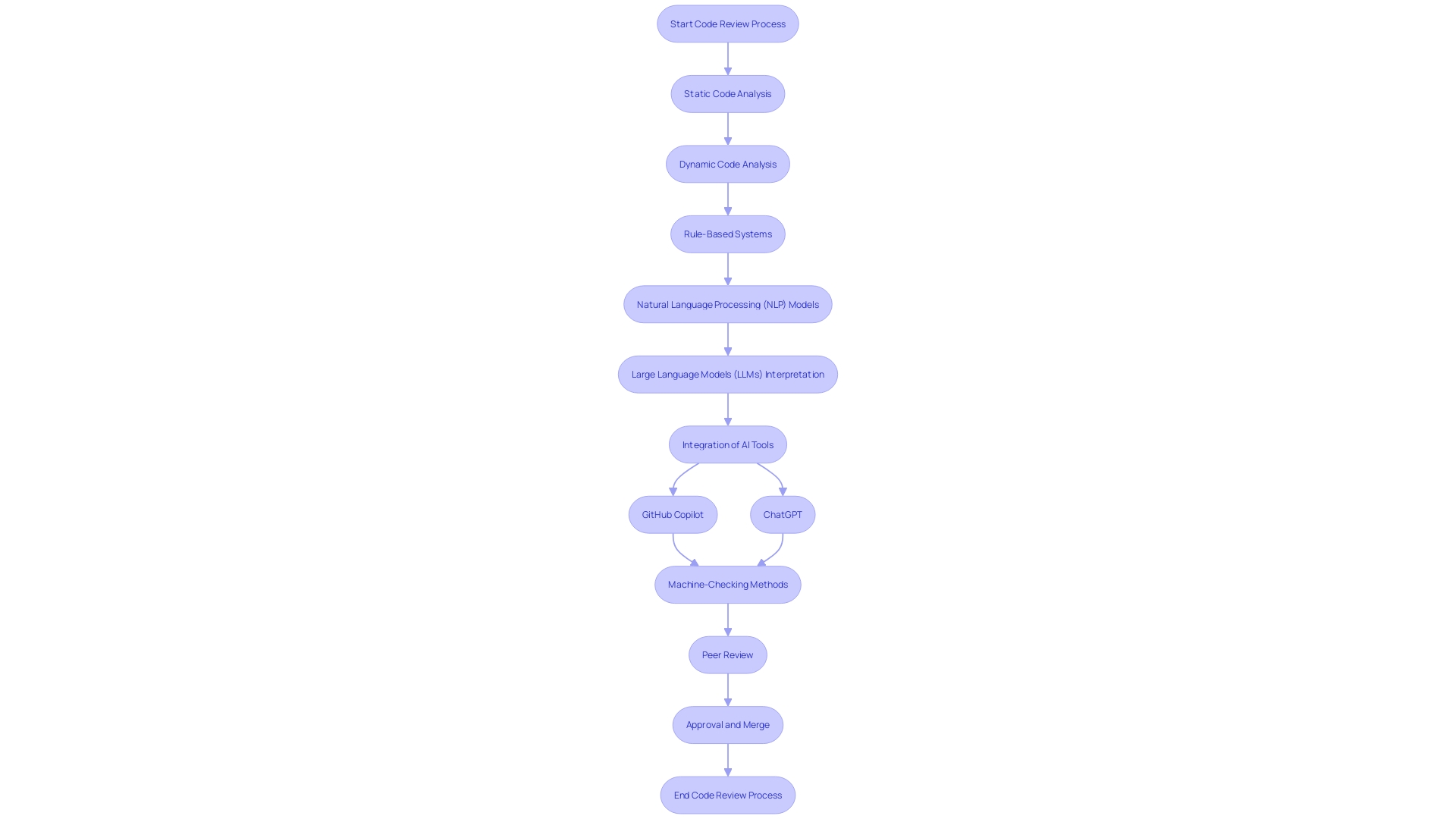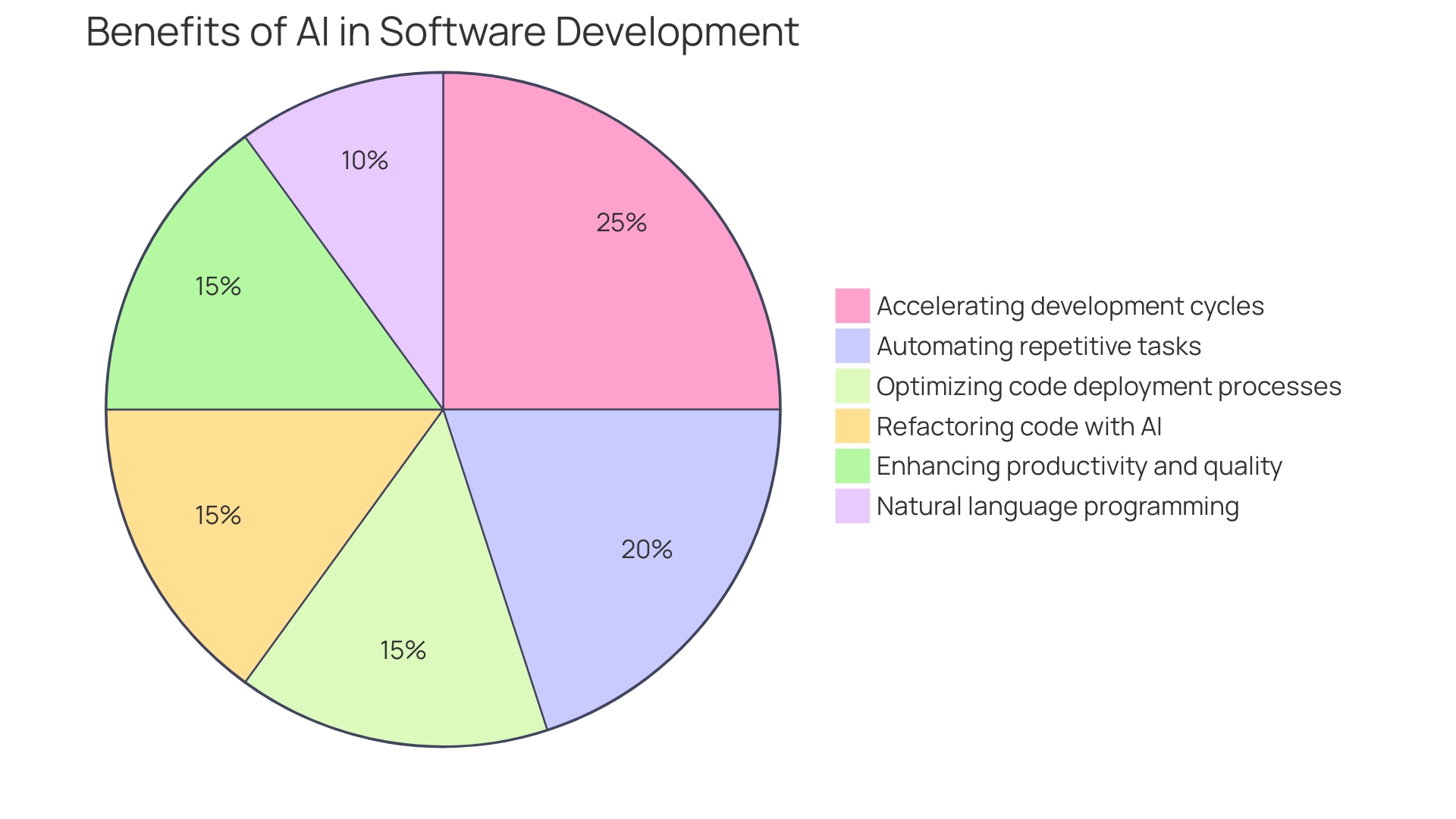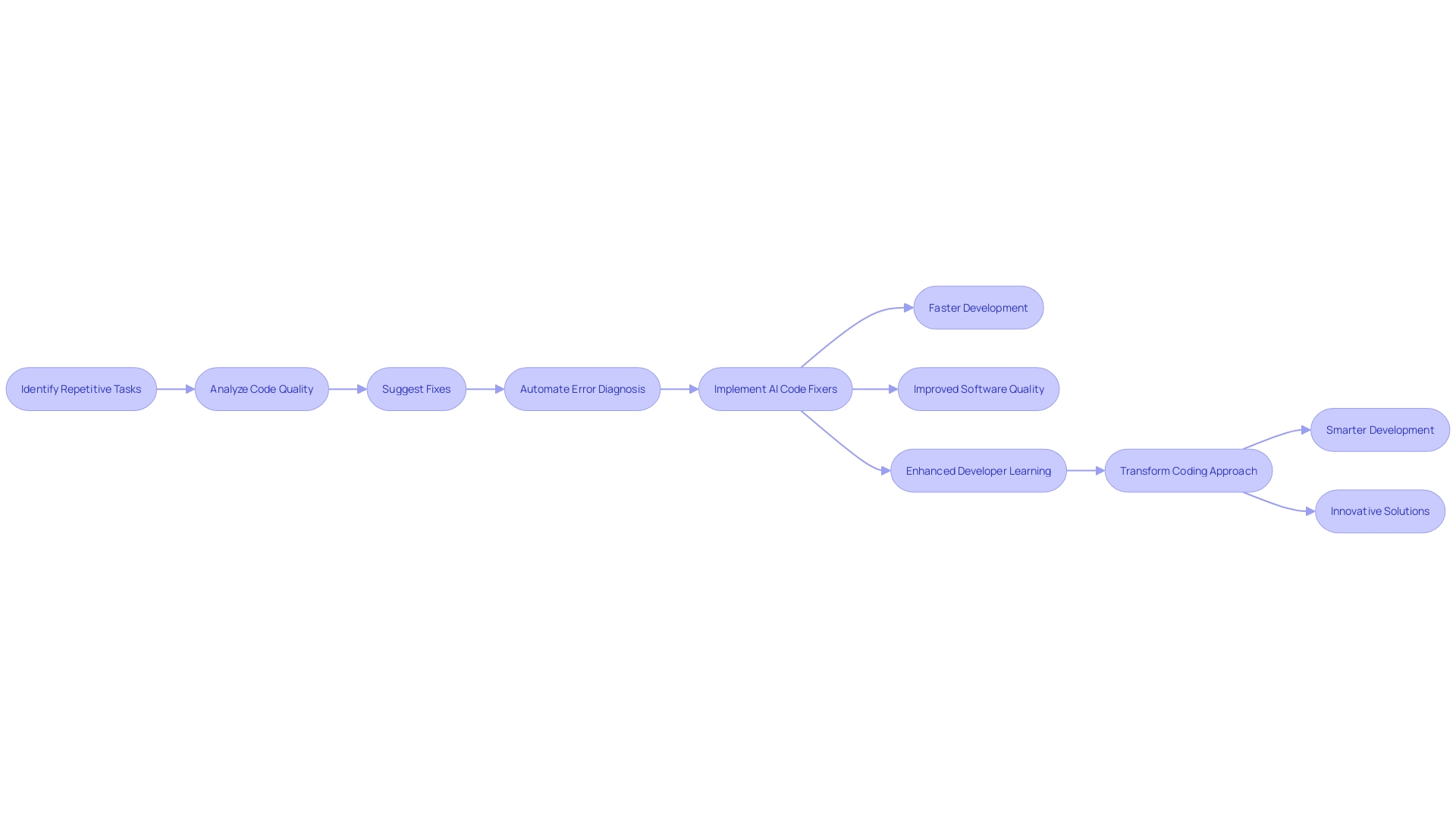Introduction
The evolution of AI in software development has revolutionized the coding landscape, with tools like GitHub Copilot and ChatGPT leading the way. However, traditional code review processes have remained stagnant, causing bottlenecks in development pipelines. Enter AI-powered code review, a comprehensive approach that leverages machine learning, natural language processing, and rule-based systems to analyze code.
This automated process identifies issues, suggests improvements, and enhances security and maintainability, setting the stage for future development. As developers worldwide recognize AI's potential, the transition from manual code review to AI-assisted methods becomes essential for innovation and excellence in software development.
What is AI Code Review?
The evolution of AI in software development is nothing short of a revolution. Tools like GitHub Copilot and ChatGPT have not only become the fastest-growing in the industry but have also introduced a paradigm shift in how we approach coding. Despite these advancements, the process of code review has remained relatively stagnant. The persistent use of decade-old methods has made code review a bottleneck in development pipelines, characterized by slow, error-prone, and expensive manual processes.
As the field of AI and machine learning (ML) expands, benchmarks like MLPerf Inference v3.1 are crucial for evaluating AI's performance across various domains, ensuring a level playing field and fostering technological advancements. These benchmarks highlight the rapid integration of AI in our daily lives and the pressing need for its application in improving code review processes.
AI-powered code review promises to address the inefficiencies of traditional methods. It's a comprehensive approach that leverages machine learning, natural language processing, and rule-based systems to analyze code. This automated process can swiftly identify issues and suggest improvements, significantly reducing the time and resources spent on manual reviews. By standardizing code and ensuring compliance, AI code review tools not only enhance the security and maintainability of software but also lay down a strong foundation for future development.
The shift towards AI-assisted code review isn't just about efficiency; it's about transforming the landscape of software development and embracing a future where AI is an integral part of the creative process. As developers worldwide recognize Ai's potential, the transition from traditional code review to AI-assisted methods becomes an essential step towards innovation and excellence in software development.
Key Components of AI Code Review
AI code review tools are reshaping the software development process by incorporating a blend of advanced techniques. Among these are Static Code Analysis, which scrutinizes code without execution to pinpoint potential bugs and security gaps, and Dynamic Code Analysis, which observes code performance during runtime to uncover errors and bottlenecks. Rule-Based Systems enforce coding standards through established regulations to maintain code integrity. But perhaps the most transformative are Natural Language Processing (NLP) Models and Large Language Models (LLMs). These AI-driven models interpret code with a nuance akin to human understanding, offering precise, contextual feedback.
The software industry is at a watershed moment, with AI's potential being harnessed more than ever. The advent of tools such as GitHub Copilot and ChatGPT has catalyzed this shift, signaling the largest growth spurt in the sector's history. While code generation tools proliferate, the code review practices have stagnated, still relying on decade-old manual methods that are often slow and riddled with errors. However, innovations like machine-checking techniques, which generate mathematical proofs to verify code accuracy, are beginning to emerge. These methods, albeit intricate and demanding high expertise, promise a revolution in code validation efficiency.
Researchers are not only advancing AI for code analysis but also aiming for the loftier goal of Artificial General Intelligence (AGI), which would surpass human intellect across various domains. This pursuit underscores the transformative potential of AI in software development and beyond. As the landscape evolves, AI tools are becoming indispensable for developers, enhancing code quality and compliance while navigating the complexities of modern software production.

Advantages of AI for Code Review
-
Efficiency and Speed: Leveraging AI in code analysis means that code can be scanned swiftly, providing developers with immediate feedback. This rapid turnaround is crucial for accelerating the development cycle, as emphasized by the recent advancements with AI pair-programming tools like GitHub Copilot, which have become indispensable for many developers. The ability to predict and complete code effectively reduces the time spent on manual coding and review.
-
Consistency and Accuracy: AI tools are programmed to adhere to predefined rules and coding standards, which they apply uniformly across the codebase. This consistent application ensures that every line of code is scrutinized without bias or variation, much like a well-structured foundation that supports the entire software architecture. The result is a higher level of code accuracy and compliance, aligning with industry standards for creating secure and interoperable software.
-
Detection of Hard-to-Find Errors: Complex and elusive errors that often slip past manual reviews are no match for AI's meticulous analysis. The technological sophistication of AI allows it to unearth intricate issues that might otherwise go unnoticed, bolstering the robustness and reliability of the final product. This precision is critical in an era where software intricacy continues to escalate.
-
Enhanced Learning and Skill Development: AI doesn't just identify issues; it also educates. Developers receive constructive insights and recommendations that foster skill improvement and adherence to best practices. The learning component is particularly beneficial for new developers, who can experience significant productivity boosts and a more enjoyable coding experience under the guidance of AI tools.
These advantages signify a seismic shift in software development practices, aligning with industry experts' observations that AI is introducing a new epoch in programming. The $1.5 trillion potential economic impact by 2030, as estimated by industry thought leaders, further underscores the transformative potential of AI in software development. With AI, the future of code review looks more efficient, accurate, and educational than ever before.

Top AI-Powered Code Review Tools
AI-powered tools are transforming the landscape of code review, offering more efficient ways to ensure code quality and security. DeepCode applies machine learning to scrutinize your code, offering intelligent suggestions that preempt bugs and errors. Pull Request marries AI precision with human insight, delivering nuanced code reviews that understand both the code and its context. CodeScene delves into your codebase with AI, pinpointing hotspots and flagging areas ripe for refactoring, enhancing maintainability and performance. Reviewable's AI-driven approach boosts collaboration, streamlining reviews for team efficiency. Lastly, Snyk's focus on AI for security helps developers spot and fix vulnerabilities early on. These tools symbolize the shifting paradigm in software development, where AI is no longer a futuristic concept but a present-day ally in writing and maintaining robust, secure code.
Generative AI in Bug Fixing
Harnessing Generative AI, developers are now embarking on a transformative journey to automate bug fixing, a critical aspect of software maintenance. This cutting-edge application of AI involves several key stages:
-
Automated Reproduction of Bugs: Through the analysis of bug patterns, Generative AI crafts test cases that can consistently trigger these bugs, offering developers a reliable way to witness and study the problematic behavior within the software.
-
Intelligent Bug Cause Isolation: By scrutinizing the codebase, AI pinpoints precise code lines at the heart of the issue. This targeted approach aids developers in swiftly locating the root cause, bypassing the tedious manual search that often hampers bug resolution.
-
Automated Bug Resolution: The AI doesn't stop at identification; it extends its capabilities to automatically generate code snippets or recommend alterations to the existing code, providing developers with actionable solutions for swift bug rectification.
This methodology has been bolstered by recent advancements in large language models (LLMs) such as GPT-4o, Claude-3.5, and Doubao Pro. These powerful tools are not only refining code generation and program repair but are also reshaping the software development landscape. LLM-based agents, armed with the capacity to perceive environments, utilize tools, and decide autonomously, are gaining traction as invaluable allies in the software development process.
The integration of Generative AI within software development promises to usher in an era of enhanced efficiency and productivity. By automating the reproduction, isolation, and resolution of bugs, developers can focus on more complex tasks, driving innovation and accelerating the time to market for new software solutions.
Benefits of Using Generative AI for Bug Fixing
Harnessing generative AI for bug fixing is transforming the landscape of software development. This innovative approach not only streamlines the bug fixing process but also enhances the precision in bug detection. By comprehensively analyzing the codebase, generative AI identifies issues that might slip past manual reviews, thereby elevating the software's quality.
Developers face a myriad of challenges, from deciphering test case failures caused by logic errors to extending functionality under uncertain implementation strategies. Generative AI steps in as an invaluable asset, offering clarity and direction in these complex scenarios. A case in point is the custom LLM, ChipNeMo, developed by Nvidia's research team. Trained on internal data, ChipNeMo aids in generating and optimizing software, demonstrating the vast potential of generative AI in specialized fields.
In the realm of software engineering, the recent advancements in large language models, such as GPT-4o and Claude-3.5, are noteworthy. These models facilitate substantial progress in code generation and program repair, which are critical to software development. For instance, Google's use of Minerva, an LLM fine-tuned on mathematical papers, showcases the capability of generative AI to produce complex mathematical proofs, significantly reducing manual effort.
Generative AI's role in software development extends beyond mere code generation. Its potential to boost productivity by an impressive 37% and support the learning process for developers is a testament to its transformative power. By integrating generative AI into their workflow, developers can not only work with greater speed but also with enhanced intelligence, tackling software challenges more effectively. Through real-world examples and case studies, the positive impacts of generative AI in bug fixing and overall software quality are evident, marking a new era in the field of software engineering.
Implementing AI Code Fixers in Your Workflow
Integrating AI code fixers into your development routine can transform your approach to coding, making the process smarter, faster, and more innovative. These powerful tools can automate repetitive tasks, provide insights into code quality, and even suggest fixes for complex errors, enhancing the overall software development cycle. Consider the way Google saves a snapshot of the code to version control every time it's edited or the use of build logs to diagnose and fix errors. This exemplifies the treasure trove of data that AI can analyze to facilitate and streamline development tasks.
AI-enhanced code analysis and generation tools have demonstrated a significant impact on productivity for developers at all levels. For example, GitHub's AI pair-programming tool, Copilot, has been pivotal in reducing task time and cognitive load while improving product quality and developer learning. Such tools use large language models to predict and complete code snippets, revolutionizing the way developers interact with their IDEs.
By incorporating AI code fixers into your workflow, you're not just resolving errors more efficiently; you're also proactively preventing them and accelerating the addition of new features. This shift towards AI-assisted development is not just a trend but a fundamental change in the way software is created and maintained. It represents the future of development, where the focus is on creativity and innovation, leaving the mundane to intelligent automation.

Best Practices for Using AI Code Review Tools
Harnessing AI code review tools effectively requires adherence to established best practices. These tools are evolving to address the inherent limitations of traditional code reviews, which are as meticulous and time-consuming as proofreading a novel line by line. AI innovations, like GitHub Copilot and ChatGPT, have changed the game by introducing capabilities to streamline the review process, which has remained largely unchanged for a decade.
To ensure software meets necessary standards before deployment, it's crucial to document the use of AI tools meticulously: what inputs were given, how the AI was utilized, and any alterations to the generated output. This not only assists in maintaining a clear record but also aids in addressing potential security concerns. A study from Stanford University highlighted an increased risk of generating insecure apps when developers rely on AI systems, underscoring the importance of thorough examination and understanding of AI-generated code.
Moreover, developers must navigate the challenges of explainability and transparency with AI-generated code, especially in critical sectors like healthcare and finance. This refers to the ability to trace and comprehend the Ai's decision-making process, which is essential for justifying the use of such technology.
A dual approach is recommended for effective AI code review: automated static analysis tools to efficiently sift through large volumes of code, identifying areas of interest for further analysis, followed by the application of Large Language Models for detailed code examination and summarization. This system addresses the challenges of scalability and efficiency in code reviews, particularly in large-scale software development projects.
In the words of Thomas Dohmke, GitHub's CEO, these AI tools are designed to keep programmers in the flow by delivering necessary information right alongside their code, reducing distractions and time spent searching for resources. By integrating these best practices, developers can leverage AI code review tools to create secure, standardized, and high-quality software, much like a strong foundation is crucial for the stability of a building.
Conclusion
AI-powered code review is revolutionizing software development by leveraging machine learning, natural language processing, and rule-based systems to analyze code. These tools offer efficient and accurate code analysis, consistent application of coding standards, detection of hard-to-find errors, and enhanced learning for developers.
Top AI-powered code review tools like DeepCode, PullRequest, CodeScene, Reviewable, and Snyk provide efficiency, precision, collaboration, and security enhancements, transforming the software development landscape. Generative AI automates bug reproduction, isolation, and resolution, streamlining the bug fixing process and enhancing bug detection precision.
Implementing AI code fixers effectively transforms the coding approach, making it smarter, faster, and more innovative. These tools automate repetitive tasks, provide code quality insights, and suggest fixes for complex errors, enhancing the overall development cycle. Adhering to best practices, such as documenting AI tool usage, ensuring explainability and transparency, and adopting a dual approach of automated static analysis and Large Language Models, is crucial for successful implementation.
In conclusion, integrating AI in code review and bug fixing processes maximizes efficiency and productivity in software development. AI-powered tools enable faster development cycles, improved code quality, enhanced security, and accelerated innovation. Embracing AI as an integral part of the creative process empowers developers to focus on creativity and innovation, while intelligent automation handles mundane tasks.
The future of software development lies in harnessing the power of AI to drive excellence and innovation.
Frequently Asked Questions
What is AI code review?
AI code review is a modern approach to examining and improving code that utilizes machine learning, natural language processing, and rule-based systems to automatically identify issues and suggest improvements. It aims to overcome the limitations of traditional, manual code reviews by standardizing code, ensuring compliance, and significantly reducing the time and resources spent on manual processes.
How do AI code review tools work?
AI code review tools work by incorporating various advanced techniques such as Static Code Analysis, Dynamic Code Analysis, Rule-Based Systems, Natural Language Processing (NLP) Models, and Large Language Models (LLMs). These technologies enable the tools to analyze code without execution, observe code performance during runtime, enforce coding standards, and provide nuanced, contextual feedback akin to human understanding.
What are the advantages of using AI for code review?
The advantages include increased efficiency and speed in code analysis, consistency, and accuracy in applying predefined rules and coding standards, the ability to detect complex errors that might be missed during manual reviews, and enhanced learning and skill development for developers through constructive insights and recommendations.
Can you name some top AI-powered code review tools?
Some of the top AI-powered code review tools include DeepCode, PullRequest, CodeScene, Reviewable, and Snyk. These tools offer intelligent suggestions, nuanced reviews, performance analysis, streamlined collaboration, and security vulnerability detection, respectively.
What is Generative AI in bug fixing?
Generative AI in bug fixing refers to the use of AI to automate the process of finding and fixing bugs in software. It involves automated reproduction of bugs, intelligent isolation of bug causes, and automated bug resolution. Large language models like GPT-4o, Claude-3.5, and Doubao Pro are being used to refine this process and assist developers in program repair and code generation.
What are the benefits of using Generative AI for bug fixing?
Generative AI for bug fixing streamlines the bug fixing process, enhances precision in bug detection, provides clarity and direction in complex scenarios, and boosts productivity by assisting in code generation and program repair. It is capable of reducing manual effort and supporting the learning process for developers.
How can implementing AI code fixers in your workflow benefit software development?
Implementing AI code fixers can make coding smarter, faster, and more innovative. These tools can automate repetitive tasks, analyze code quality, suggest fixes for complex errors, prevent errors, and accelerate feature addition. They also help reduce task time and cognitive load, improving product quality and enhancing developer learning.
What are some best practices for using AI code review tools?
Best practices include meticulously documenting the use of AI tools, understanding and examining AI-generated code, addressing security concerns, and ensuring explainability and transparency in AI-generated code. Combining automated static analysis tools with Large Language Models for detailed code examination is recommended for scalability and efficiency. Integrating these practices allows developers to create secure, standardized, and high-quality software.




